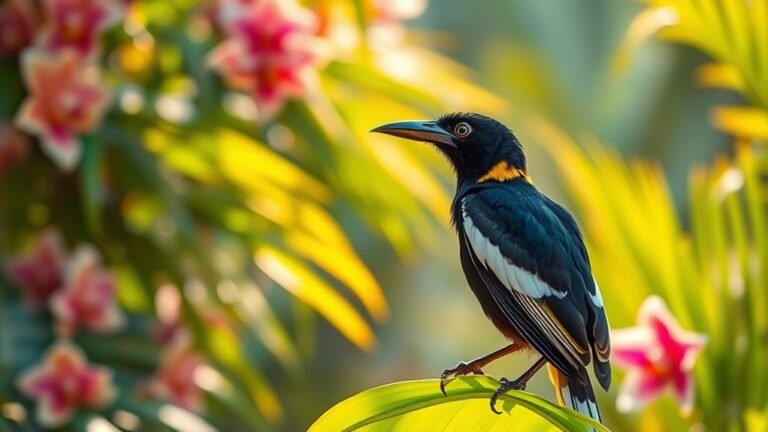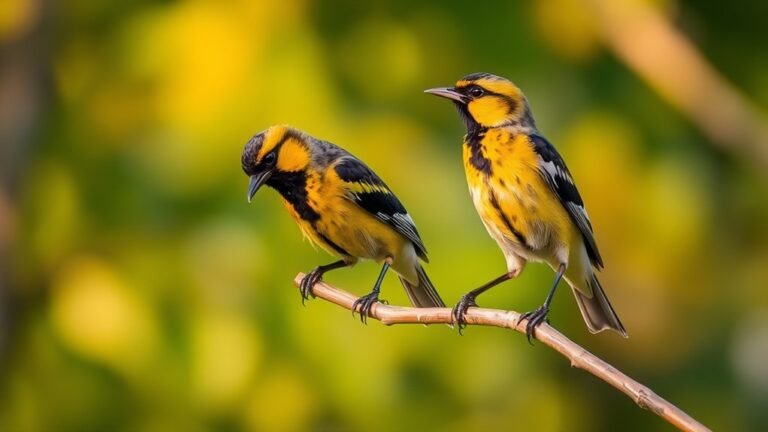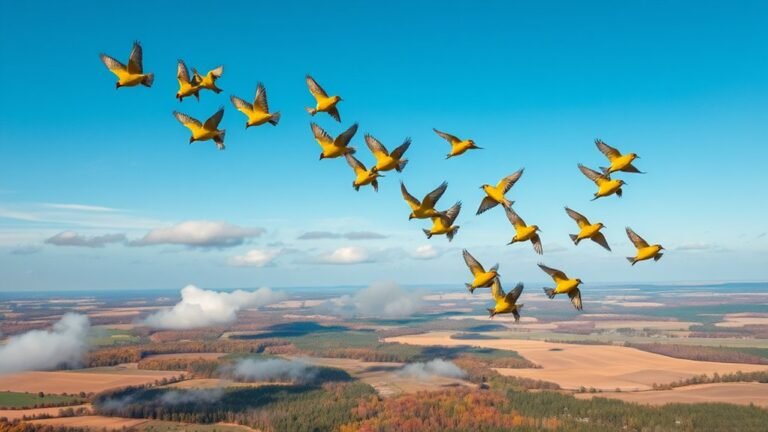How Many Crows Make a Murder? Mystery Solved
When you hear "murder of crows," you may wonder what it means. This term does not specify a set number of crows but reflects their social nature. Crows are intelligent and form complex social bonds. Their gatherings suggest important interactions and behaviors. Understanding these dynamics can reveal more about how crows relate to one another.
Key Takeaways
The term "murder of crows" describes a group of crows, but it does not specify a number needed for this term. Collective nouns like "murder" arise from cultural views and the traits seen in these animals. Crows are smart and scavengers, which helps form the dark image tied to the word "murder." Historically, this term reflects how society views nature and connects language to animal behavior. Knowing where these terms come from helps us appreciate both language and nature better.
The Origins of the Term "Murder of Crows"

The term "murder of crows" sounds dark, but it has simple historical roots in the English language. It comes from how people in medieval England created collective nouns based on animal traits.
Crows are scavengers and often linked with death, which led to the term "murder." This shows how language reflects cultural views on nature.
Collective nouns like this one connect language and the natural world, making it interesting for language lovers. Understanding where this term comes from helps you see the connection between language and how we view our surroundings.
The Intelligence of Crows: A Closer Look
Crows are highly intelligent birds, and their intelligence is evident in many ways. Understanding the term "murder of crows" can lead to a greater appreciation for these fascinating creatures.
Here are some key traits that highlight their cognitive abilities:
- Tool Use: Crows can make and use tools to get food.
- Social Learning: They learn by watching other crows and adapt their behavior to survive.
- Memory: Crows have strong memories that help them remember where food is and recognize individual people.
- Planning: They can think ahead and prepare for their future needs.
These traits illustrate the smart behavior of crows, showcasing them as one of the smartest bird species.
Learning about their abilities can help us appreciate these remarkable animals even more.
Social Structure: Understanding Crow Communities

Crows live in organized social groups. These groups have a clear hierarchy that defines the roles of each crow. Dominant crows lead searches for food and choose nesting sites. Subordinate crows help but don't compete with dominant members. This structure helps the flock work together, which is vital for survival and finding resources.
Understanding these relationships shows how crows form strong connections and work as a team. Their social networks are essential for learning and adjusting to changes in their environment. Each crow's position in the hierarchy supports the group's stability.
This balance of helping and competing is fascinating and showcases the intelligence of these birds. Recognizing their social structure can deepen your appreciation for crows and their behaviors.
Communication Among Crows: Language and Signals
Crows are more than just scavengers. They've a clear system of communication that helps them connect with each other.
Here are important ways crows communicate:
- Caws and Calls: Crows make different sounds for danger, finding food, or showing their place in social groups.
- Posture: When a crow stands upright, it shows confidence. A lowered body means it's showing submission.
- Wing Flicks: Quick movements of their wings can catch attention or indicate when they're ready to breed.
- Eye Contact: Looking directly at another crow can strengthen their bond and show who's in charge.
Understanding these signals can help you appreciate the intelligence and social nature of crows.
Myths and Folklore Surrounding Crows

Crows have a rich history in many cultures. Many societies see them as symbols of mystery or omens. In Native American cultures, crows are often viewed as protectors. In contrast, European folklore tends to see them as signs of death. Urban legends frequently describe crows as dark creatures that signal bad events.
Their black feathers and clever behaviors spark interest and lead to stories linking them to fate and the unknown.
Crows represent humanity's mixed feelings about nature, combining both respect and fear. This duality makes them fascinating figures in our shared stories. Recognizing these myths helps us connect with diverse cultural traditions.
The Lifecycle of a Crow: From Nesting to Maturity
Crows have a distinct lifecycle that begins with nesting. They choose safe locations to build their nests and protect their eggs.
Here's an overview of their developmental stages:
- Hatching: After about 18 days of incubation, eggs hatch into vulnerable chicks.
- Fledging: In 3 to 4 weeks, the young crows leave the nest and start to fly.
- Learning: Young crows observe adults to learn how to find food and understand social dynamics.
- Independence: By 4 months, they reach maturity, ready to mate and build their nests.
How Many Crows Really Constitute a Murder?
Crows often come together in groups, which raises the question of what defines a "murder" of crows.
This term isn't based on a specific number but refers to groups of three or more crows. Observing these gatherings reveals that crows have strong social structures.
They communicate and cooperate in impressive ways. Whether you see them as mysterious or intelligent, their group dynamics enhance our appreciation of birds.
The presence of crows connects us to nature and fosters a shared interest in these fascinating animals.
The Role of Crows in Ecosystems
Crows play important roles in ecosystems, contributing to environmental health. Their natural behaviors provide several key benefits. Here are four significant roles crows fulfill:
- Scavengers: Crows eat dead animals, which helps manage waste and stops diseases from spreading.
- Seed Dispersers: When crows bury food, they aid in the growth of plants and increase biodiversity.
- Pest Control: Crows consume insects and small rodents, helping to control pest populations in farms and natural areas.
- Indicators of Ecosystem Health: The presence and actions of crows can reveal changes in the environment, supporting conservation efforts.
These roles show how essential crows are to maintaining a balanced ecosystem. Their behaviors not only benefit the environment but also enrich the habitat they share with other species.
Common Misconceptions About Crows
Many people misunderstand crows and this affects how they see these birds. A common belief is that crows are linked to death or bad luck because of stories in folklore. However, crows are smart and social animals with advanced problem-solving skills. They show their intelligence through their foraging habits and how they gather in groups. This goes against the idea that they only bring misfortune.
Crows also have specific calls for communication, showing their strong social ties. By learning the truth about crows, you can appreciate these amazing creatures and understand their role in nature. This knowledge helps you feel connected to the larger ecological community.
The Cultural Significance of Crows Throughout History
Crows hold significant meaning in many cultures throughout history. Their symbolism reflects various important themes.
Here are key aspects of how crows are viewed:
- Messengers: In many traditions, crows act as links between the physical and spiritual worlds.
- Intelligent Creatures: Crows are known for their smart problem-solving skills and adaptability.
- Spirit Guides: Many folk tales describe crows as helping souls find their way after death.
- Nature's Cleaners: As scavengers, crows play an essential role in maintaining ecological balance.
Understanding these meanings strengthens our appreciation of crows across different cultures. They're more than just birds; they hold deep significance in our shared human experience.
Frequently Asked Questions
What's the Average Lifespan of a Crow in the Wild?
In the wild, crows typically live between 10 to 15 years. Their lifespan depends on several key factors. These include the type of habitat they live in, the availability of food, the presence of predators, and interactions with humans. Each of these factors can significantly impact a crow's survival and health in nature. Understanding these elements helps us appreciate the challenges crows face as they thrive in various environments.
Do Crows Have Predators?
Crows have several predators. They face threats from hawks and owls. Mammals, such as foxes, can also hunt crows. Crows are smart and often work together in groups. This teamwork helps them avoid predators and stay safe.
Can Crows Recognize Human Faces?
Crows can identify human faces. They learn from their interactions with people. Crows remember those who are threats and those who offer food. This ability shows their intelligence and how they form relationships with humans.
How Do Crows Find Their Food?
Crows use simple methods to find food. They search visually and probe the ground. They also hide food for later, showing their smartness and ability to adapt. Their foraging skills help them solve food-related problems effectively.
Are Crows Monogamous or Polygamous?
Crows have different mating habits. Some crows form monogamous pairs, while others are polygamous. This difference affects their family structure and social dynamics. Their relationships can influence how they interact within their groups, showcasing interesting cooperative behaviors.

Kashvi is a passionate bird enthusiast and nature lover who has been fascinated by the world of birds for years. With a keen eye for detail and a love for learning, Kashvi is dedicated to sharing her knowledge and insights with fellow bird enthusiasts on Avian Enthusiasts. Through her engaging and informative articles, Kashvi aims to inspire others to join her in exploring the fascinating world of birds and to promote a deeper appreciation for these incredible creatures.







